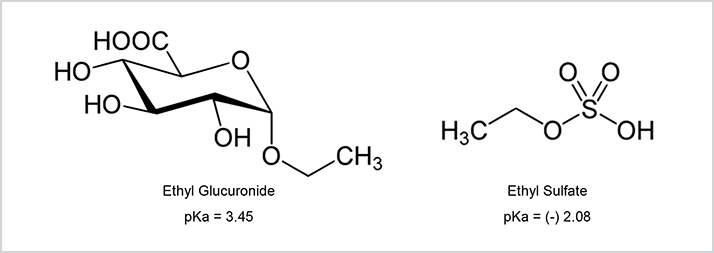Introduction
Ethyl glucuronide (EtG) and ethyl sulfate (EtS) are conjugated ethanol metabolites formed in low amounts in the body following alcohol consumption. Compared with ethanol, EtG and EtS are excreted in urine for a prolonged time. Published literature indicates that EtG may be detectable for up to 80 hours after alcohol ingestion, while EtS is generally detectable for up to 24 hours after use, making them both valuable as sensitive alcohol biomarkers. The detection of these metabolites has proven advantageous for zero tolerance treatment programs and abstinence enforcement where information regarding recent alcohol consumption is required. The cutoff level for EtG confirmation is typically 500 ng/mL or higher; the EtS confirmation cut-off level is generally set at 100 ng/mL.
When analyzing chemical residues in a complex biological matrix, such as urine, a sample pre-treatment step is generally required to eliminate non-desirable matrix components and/or concentrate the analyte(s) of interest. However, due to the highly polar nature of EtG and EtS (log P of 1.51 and 0.62, respectively), many labs turn away from traditional sample preparation procedures and instead use a dilute-and-shoot or simple filtration approach. These techniques do not adequately remove interferences from the sample and significant matrix suppression is commonly experienced during instrumental analysis. This is further complicated by the lack of retention of EtG/EtS on a traditional reversed phase HPLC column.


UCT has developed a line of products that allows for the efficient analysis of EtG and EtS in urine. By pairing UCT’s FASt® ETG SPE cartridge with a Selectra® ETG HPLC column, cleaner extracts and lower LOD’s/LOQ’s can be achieved when comparing to a dilute-and-shoot method.
Procedure
- Sample and diluents are added in an appropriately labeled tube. Add appropriate volume internal standard(s). It is recommended to use an internal standard volume of no more than 200 μL.
- Set up extraction manifold with FASt® ETG cartridges and auto-sampler collection vials.
- Pour sample into FASt® ETG cartridges and elute sample directly into auto-sampler vials.
- Cap vials and put directly onto LC/MS for analysis.





